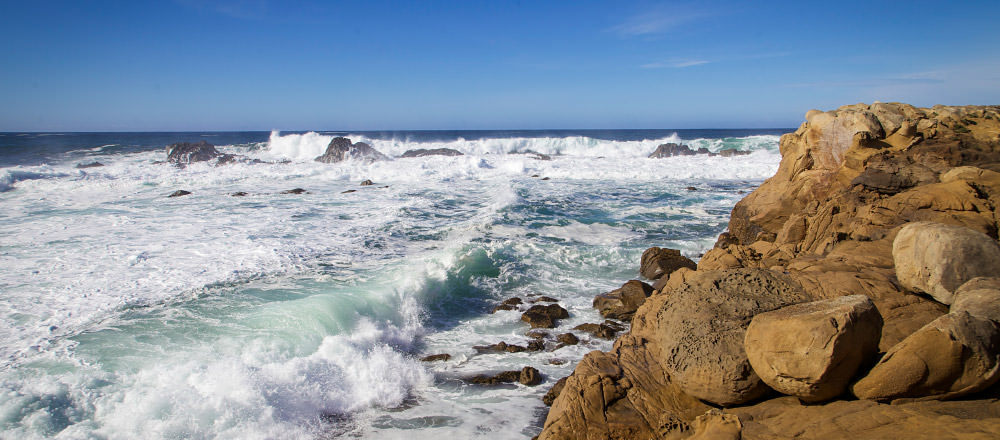
"Ocean Climate Indicators: A Monitoring Inventory and Plan for Tracking Climate Change in the North-central California Coast and Ocean Region" (PDF, 5.6Mb) is now available!
The plan, authored by a working group of the Greater Farallones National Marine Sanctuary Advisory Council is the culmination of a 2-year collaborative and interdisciplinary effort with input from over 50 regional research scientists and resource managers. Thirteen of these experts representing ten different federal and state agencies, NGOs, and research universities participated in the working group with the support of three sanctuary staff members. As part of this effort, the working group developed an indicators- based monitoring goal for the region and recommended objectives, strategies, and activities to meet this goal. The working group also developed recommendations for the priority levels of the monitoring activities; compiled information about the best-available monitoring for each indicator; assessed knowledge gaps that improved indicator monitoring could fill; and provided case studies of potential management uses for each indicator.
What are climate change indicators?
Climate change indicators are measurements that provide important information about the status and trends of climate change impacts within a region. The climate change indicators shown in the figures above were specifically developed for the North-central California coastal region, including the Pacific coastline of the San Francisco Bay Area.
How were these indicators selected?
The ocean climate indicators were developed following a modified version of the procedure used in the National Research Council's report, Ecological Indicators for the Nation. The process used in the Ocean Climate Indicators Project is outlined below:
-
An extensive review of available publications about climate change in the North-central California coast and ocean region informed the creation of an ecosystem description and a conceptual model that highlight the most important components within the ecosystem and the processes by which anthropogenic climate change can impact them. A large set of over 100 candidate physical and biological indicators was developed based on the findings of this literature review.
-
Discussions with sanctuary and other management then assisted with the creation of a set of priority management questions that the best indicators should address.
-
Indicator selection criteria, which assess the relative strength of each indicator, were created based on those used in Ecological Indicators for the Nation.
-
The project team used the indicator selection criteria and the priority management questions to reduce the large set of candidate indicators to a smaller set of 10 physical and 13 biological climate change indicators.
-
Over 50 regional research scientists and resource managers evaluated the smaller set of 23 indicators by completing an Indicators Survey that assessed how well each indicator met the indicator selection criteria.
-
36 of the Indicators Survey respondents provided additional input about the potential ocean climate indicators at the Indicators Workshop in August 2012. Workshop participants were divided into four breakout groups, and each group determined which indicators they thought were most promising. Indicators recommended by at least three breakout groups were considered to be “Consensus Indicators.” Download the full Workshop Summary Report (PDF, 2.4MB).
-
Follow-up discussions with the indicators project team led to the conclusion that all of the Consensus Indicators should be included in the final set of Ocean Climate Indicators. These indicators are displayed in the figures above.
How will these indicators be used?
These climate change indicators were specifically developed for use by regional decision-makers and resource managers to ensure that they have the best-available scientific information as they work to adapt to and reduce the impacts of climate change. For example, GFNMS management might use the indicators to identify portions of the sanctuary that are the most vulnerable to climate change to aid in planning restoration projects. These climate change indicators can also be used by research scientists to track changes in key physical and biological components of the North-central California coastal ecosystem.
Why is this project important?
Prior to the Ocean Climate Indicators Project, no climate change indicators existed for the North-central California coastal region. These are also the first regional climate change indicators in the National Marine Sanctuary System.
Climate change indicators scaled to larger regions (including the State of California and United States) are very valuable for large-scale assessments of the impacts of climate change, but they are less useful for regional planning efforts because they do not specifically consider the very unique habitats in the North-central California coast and ocean. Strong upwelling during spring and summer months makes the region one of the most biologically productive areas in the world. For example, the region is:
- An economically vital center of tourism, shipping, and fisheries
- Key habitat for 26 endangered or threatened species and at least 36 species of marine mammals including the California gray whale and Pacific humpback whale
- The location of one of the world's largest seasonal congregations of white sharks
- Home to the largest concentration of breeding seabirds in the contiguous United States
- One of only a handful of major upwelling regions in the world
Who supported this work?
The Ocean Climate Indicators Project is a postdoctoral fellowship project supported by the Postdocs Applying Climate Expertise (PACE) program, which is administered by the University Corporation for Atmospheric Research (UCAR), and co-sponsored by the Greater Farallones National Marine Sanctuary and the USGS Western Ecological Research Center (WERC). Dr. Duncan's advisors are: Kelley Higgason, M.S., GFNMS (lead decision-making advisor); Dr. Tom Suchanek, USGS-WERC (lead research advisor); Dr. Jay Stachowicz, UC Davis; Dr. Dan Cayan, Scripps Institution of Oceanography and USGS National Research Center, Western Region; and Dr. John Largier, UC Davis.
For more information, please contact: Benét Duncan, or Kelley Higgason

